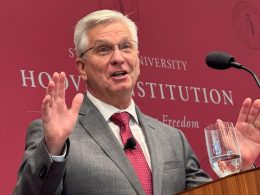After Donald J. Trump entered the White House in 2017, The Washington Post adopted a slogan that underscored the newspaper’s traditional role as a government watchdog: “Democracy Dies in Darkness.”
This week, as Mr. Trump prepares to re-enter the White House, the newspaper debuted a mission statement that evokes a more expansive view of The Post’s journalism, without death or darkness: “Riveting Storytelling for All of America.”
The statement is meant to be an internal rallying point for employees, according to two people with knowledge of the decision. Executives are not planning to replace its more strident public slogan. Suzi Watford, The Post’s chief strategy officer, has been previewing it to some employees this week.
The new mission statement comes amid turmoil in the newsroom. Since June, The Post has been reeling from a series of crises that has resulted in widespread dissatisfaction with Will Lewis, the company’s chief executive. On Wednesday, more than 400 employees sent a letter to Jeff Bezos, the paper’s billionaire owner, requesting a meeting to discuss leadership decisions that they said “led readers to question the integrity of this institution” and that “prompted some of our most distinguished colleagues to leave.”
Mr. Bezos, the founder of Amazon, has made comments in line with the new mission statement in conversations with Post journalists in recent years, according to two people familiar with those discussions. Mr. Bezos has expressed hopes that The Post would be read by more blue-collar Americans who live outside coastal cities, mentioning people like firefighters in Cleveland. He has also said that he is interested in expanding The Post’s audience among conservatives, the people said.
The Post has already begun to consider ways to sharply increase the amount of opinion commentary published on its website, according to two people with knowledge of the talks. An adviser to The Post, Lippe Oosterhof, has conducted brainstorming sessions about a new initiative that would make it easier to receive and publish opinion writing from outside contributors.
The Post has also tried to draw a sharper distinction between its news and opinion content.
A spokesman for Mr. Bezos did not respond to a request for comment.
A slide deck Ms. Watford presented to executives this week explained the origins of The Post’s new mission statement in greater detail. “Storytelling,” the deck says, should “bring a relentless investigative spirit, backed by credible sources, to deliver impactful stories in formats the world wants,” according to two people who saw the presentation. Reaching all of America will require The Post to “understand and represent interests across the country,” it says, and “provide a forum for viewpoints, expert perspectives and conversation.”
Ms. Watford, who joined The Post in April, also laid out big-picture goals for the company. Among them: reach 200 million paying users, which the slide deck described as a “Big Hairy Audacious Goal,” or “B.H.A.G.”
The slide deck compares the 200 million target with efforts to land a man on the moon — and it is an ambitious goal: The Post currently has fewer than three million digital subscribers; The Times, an industry leader, has roughly 11 million.
Most publications in The Washington Post’s peer group fall well short of reaching 200 million people, according to data from the analytics firm Comscore. The New York Times, The Washington Post, Axios and Politico all generated fewer than 100 million monthly total viewers for the first half of 2024, paying and non-paying, though they saw an audience spike around the presidential election.
The Post’s new target specifically mentions “users,” not “subscribers,” suggesting that the company may pursue different ways of getting payments from readers. Internal data circulated by The Post shows that the newspaper reaches many millions of consumers on platforms such as Apple News, social media and podcasts. Those audiences tend to be younger, but they’re also much harder to make money from, since the bulk of advertising dollars and subscriber fees go to other platforms.
The slide deck that Ms. Watford presented describes artificial intelligence as a key enabler of The Post’s success, the people said. It describes The Post as “an A.I.-fueled platform for news” that delivers “vital news, ideas and insights for all Americans where, how and when they want it.” It also lays out three pillars of The Post’s overall plan: “great journalism,” “happy customers” and “make money.” The Post lost roughly $77 million in 2023.
But many aspects of The Post’s new mission have nothing to do with emerging technology. The slide deck includes a list of seven principles first articulated by Eugene Meyer, an influential Post owner, in 1935. Among them: “the newspaper shall tell all the truth” and “the newspaper’s duty is to its readers and to the public at large, and not to the private interests of its owners.”








